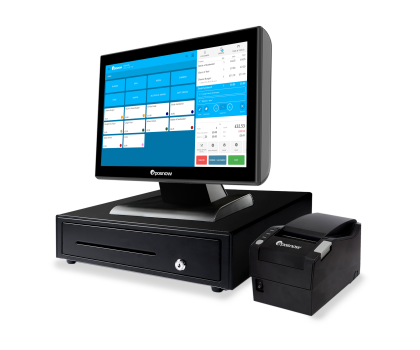Long and Short Term Restaurant Goals
When running a hospitality business, it can be easy to focus on day-to-day operations and put long and short-term restaurant goals on the back burner.
Creating goals can be challenging when you’re experiencing limited cash flow in a highly competitive field or feel that your business decisions aren’t resonating with your customers.
We look in detail at three common restaurant goals: increase profit and revenue, improve employee performance, and achieve effective business growth.
Increase profit and revenue
From small restaurant business loans to yearly sales, understanding your restaurant's finances ensures it can continue functioning and remain lucrative. The odds are stacked against you since restaurants have notoriously low-profit margins[1]. However, there are ways to make good profits with the right strategy.
Choose a cost focus strategy
A cost focus strategy works well for businesses that cannot raise their prices without putting off customers. This term refers to a strategy that reduces prices to attract customers but maintains profit margins by simultaneously reducing operating expenses.
Typical methods of lowering operating costs in hospitality are optimising staff levels, reducing utility usage or rates, and finding cheaper suppliers (while maintaining the best possible quality).
Altering your menu to use in-season ingredients can lower food costs while improving the quality and freshness of your menu. Or, you could work to optimize your supply chain. Working closely with farmers rather than buying from wholesalers could mean getting a better cost for the same high-quality ingredients.
Create a menu pricing strategy
The pricing of menu items is the most important deciding factor for some people when choosing where to dine. Your menu pricing strategy helps you determine how much you’ll charge for each dish, taking your entire menu and other aspects into account. These aspects include:
- Direct costs such as food waste, food cost, portion sizes, and customizations
- Indirect costs like water, gas, and employee labour
- Overhead expenses like rent, interior design, and renovation costs
- Seasonal costs such as heating/cooling during hot and cold months and the additional expenses associated with each time of year
Improve inventory management
Stringent inventory control could save your restaurant a lot of money. Food waste and shrinkage (loss of inventory through wastage or theft) massively impact costs in many restaurants, so tackle this by having a constant overview of stock levels.
More and more restaurants perform inventory management through a point of sale (POS) with a built-in inventory management system. This allows them to enter precisely how much of every ingredient each dish consumes. Then with every sale, the till updates the master inventory level, and ingredient levels remain accurate all the time, with less need for manual stock checking procedures.
Set goals that target waste, too. This includes strict portioning in the kitchen and careful food storage. Not only will this improve your bottom line, but it will make your business a lot more environmentally sustainable.
For an integrated EPOS solution that will take care of in-house and takeaway sales, try Epos Now's specialised restaurant system:
- Integrate multiple sales platforms and manage them through one place
- Manage stock and product data quickly and easily
- Know your business with hundreds of modifiable, detailed, downloadable reports
- Be supported all the way with an expert team on hand 24/7

Improve employee performance
Often, employees serve as the face of the company. Aside from simply fulfilling their duties, they are responsible for making guests feel welcome, and creating a good atmosphere. They also play a key role in building your brand.
In a survey of 568 businesses, Harvard Business Review found that 71% of managers feel employee engagement is one of the most important factors in organizational success[2]. Finding the right employees and ensuring they feel motivated is crucial.
So, what can restaurants do to boost engagement and productivity?
Training and development plans
Discuss plans for progression with employees to better understand their long-term goals with your company. Some people may apply to your job for seasonal work, while others may be seeking a career. Either way, encourage honesty and filter their response into your development and training plans.
As well as providing initial training, consider giving ongoing training to existing staff as a refresher on how you’d like to operate. Include training that keeps your business goals in mind as well as parts of the role a staff member has struggled with:
- Procedures for complaints and dealing with difficult customers
- Refresher courses on health and safety training
- Sales, service, and/or food preparation skills

Consider employee opinions when making decisions
Employees experience firsthand how operational decisions affect the business. Listen to suggestions for improvement with an open mind and make employees feel you value their thoughts.
Sometimes, restaurant owners enforce policies that positively impact revenue but negatively affect staff morale. It’s your duty as a business owner to decide the order of priority for these things and find a happy medium. Sometimes explaining the reasoning behind decisions can help employees cope with them.
Different employee positions bring valuable perspectives that restaurant owners cannot access. Age discrimination studies show younger staff working in more customer-orientated roles, or those in more junior roles, receive different customer feedback than those in managerial positions[3].
Effective business growth
Growth can be hard to define since success and growth look different to different business owners.
A business can achieve growth through a combination of planning, growth strategy, marketing strategy, and SMART goals. SMART goals are specific, measurable, achievable, relevant, and time-based targets. Below are a few examples of smaller goals that can accumulate into long-term growth.
Increase versatility
Offering discounts, loyalty programs, and gift cards can help restaurants reach new audiences and retain existing customers.
Of course, certain types of discounts may not align with your brand. For example, it’s unlikely that a Michelin-starred restaurant will run a happy hour every Tuesday night.
If you’ve completed a yearly sales review and one month, in particular, stands out for having poor sales, then consider running a limited-time offer where you introduce a specials menu for a slightly lower price. Managers that isolate and target weak times and areas of trade can then boost sales while giving customers an incentive to visit.
Expand your offerings
While this sounds expensive, you can reach a wider audience and improve your relationship with current customers by offering an alternative to the traditional dining experience.
In such competitive environments, businesses need to be adaptable and creative with their operations to gain appeal. Many restaurants have expanded to offer takeout. Offering takeaway has a range of benefits:
- Restaurants are no longer restricted to table capacity and can serve more customers at once
- Increased sales channels
- Accessible to a wider range of customers
- Lower labour costs
POS integrations like Order & Pay enable delivery, click and collect and tableside ordering for a contactless dining experience.
Track business performance with precision
Using Epos Now software, you can review KPIs and detailed sales analyses with ease. Our multi-award-winning electronic point of sale (EPOS) software has specialist functions for every industry, allowing you to access the most relevant, innovative EPOS reports for your hospitality business.
- View sales reports by item, profit margin, or time
- Attach allergy and ingredient information to products to keep your front-of-house team fully informed
- Review sales performance by employee
- Track stock levels with a live inventory check, linked to the POS
- Manage tables by colour code to track time spent in the restaurant, and maintain solid turnover
- Save time using a built-in CRM system
- Benefit from over 100 app integrations available, including bookkeeping, accounting, and loyalty program applications
Request a free callback with Epos Now by submitting your details below
Choose an EPOS trusted by 40,000 businesses and the very best restaurants




